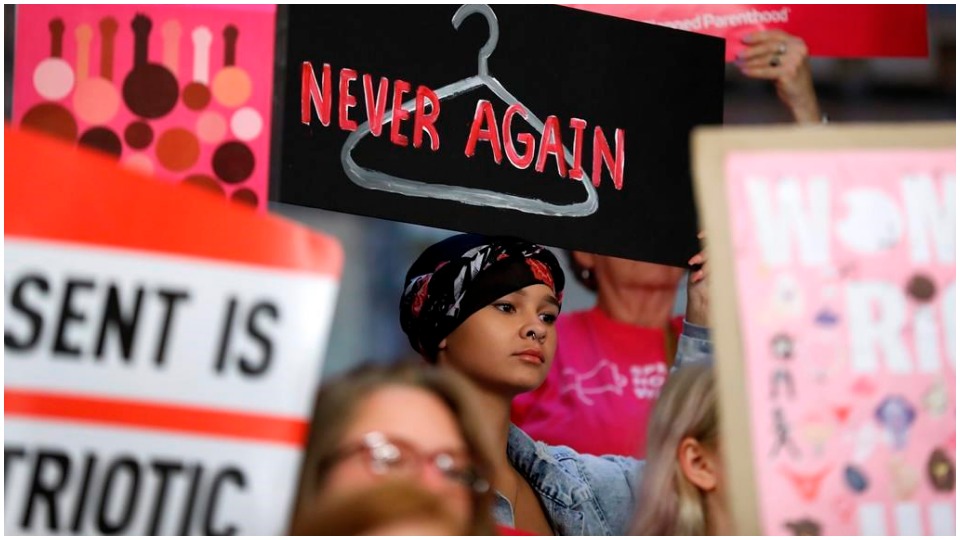
Republican attacks on Planned Parenthood and on the ability of women to access abortion facilities and even accurate medical advice have captured headlines throughout the country. In one state after another, legislatures have passed restrictive laws that all but eliminate the right to terminate a pregnancy. The landmark Supreme Court ruling in Roe v. Wade may itself be endangered considering the present makeup of the Court with two new Trump appointees now sitting on the bench.
How do reproductive rights play out in Congress?
The Population Connection Action Fund is the political arm of Population Connection, the nation’s largest and oldest grassroots organization concerning itself with birth and population control. Its members and advocates are deeply invested in supporting family planning programs both domestically and globally.
Its recently released Congressional Report Card 2019 tracks the voting records of 100 U.S. senators and 435 U.S. representatives in the 116th Congress on issues of concern to the reproductive rights community. Not surprisingly, there is a vast discrepancy between the two major parties, showing nearly 100% unanimity of Republicans vs. Democrats, a frighteningly wide gap.
At first glance, some questions emerge, such as: Don’t Republicans and Democrats alike have wives, sisters, and daughters who would all equally benefit from enlightened reproductive rights policies? Don’t they all recognize that of course family planning is not just a women’s issue but precisely a family issue that affects all Americans? If the current debates are in theory about morality and such heady but essentially theological questions like the beginning of human life, how is it that sincere, practicing religious people do not agree across the aisle, but are divided in their votes not by faith but by party?
Such questions are in essence beside the point. Reproductive rights, like Social Security, healthcare, education, environmental policy, criminal justice, debt, and everything else, are subsumed under the larger questions of democracy and the disposition of authority. Who has the right to determine policy? In other words, who rules? In Marxist terms, which class has power?
For many reasons, it is in the interest of the class in power to restrict reproductive rights. Keeping women in submission by disallowing them control over their own bodies and their own families is keeping the whole working class down. Republican legislators who may need an abortion for their mistresses or their daughters can always find one in the private sector.
Connections between the issues of race, abortion, jobs, and immigration have not been adequately explored. Left to the birth and mortality statistics of the U.S.-based population alone, the birthrate is falling; as fewer families can afford to have more children, they’re having them later, or not at all. If the population of the U.S. is increasing, it’s the immigrant birthrate that is responsible. These are in fact the actuarial characteristics of most of the socially advanced nations of North America and Europe.
Therefore, to encourage a future “whiter” population, the right wing wants to limit immigration, ban abortion for women already in the U.S., and increase the native-born birthrate. If there will be fewer industrial jobs in the future owing to robotics and other forms of technology, the U.S. will still need service workers, and the racists in Congress would prefer them to be whiter.
Within those overall policy goals, there are some nuances. For example, the same right wing that wants to illegalize abortions also works furiously to keep the general population sick and poor by not passing national healthcare legislation and keeps Black, Brown, and Native women from receiving equal and adequate prenatal and other medical care. So the infant mortality rate, and rate of women who die in childbirth in those communities, is measurably higher. Presto! Fewer Black and Brown women and babies!
Thus the statistics on longevity and infant mortality, which are used to assess the overall health of a nation, are just about comparable now between the U.S. and Cuba, despite the enormous difference in wealth between the two nations. Owing to its backward, unscientific policies on health care in general, and sex education and reproductive rights in particular, the U.S. falls toward the very bottom of the list of advanced industrial countries in terms of overall health and welfare.
Looking at the following Congressional report card, keep in mind the underlying ideological set that determines these votes, and that will help to explain why there is almost no overlap between the two parties on issues of science and health that to the innocent eye would otherwise seem clear and undebatable.
Yes, the Democratic Party is still a party of capitalism—although if there are socialists in Congress (and there are), they are all, with the exception of one or two Independents, Democrats. It is up to the electorate to determine the future course of our Congress, but on many issues that do not directly engage the question of socialist transformation, it is critical to pay attention to divisions and openings within the ruling class. They are not all of the same mind, and these differences mean a lot to women, children, families, and men—in other words, everyone. As they say, elections matter.
In the Senate
Population Connection singled out only one Senate vote for evaluation. It was the Ban on Abortion Coverage in the Affordable Care Act (ACA), voted on Jan. 17, 2019. In the midst of a government shutdown, Senate Majority Leader Mitch McConnell brought to the floor the misleadingly named “No Taxpayer Funding for Abortion Act.” The bill would have codified the Hyde Amendment and barred anyone receiving subsidies for health care under the ACA from purchasing any plan that covered abortion services. The bill failed to gain the 60 votes needed to end debate and move to a final vote.
The Population Connection position was to oppose this bill, which failed 48 to 47, with five senators not voting (interestingly, all Republicans: Mike Crapo, Ida.; Rand Paul, Ky.; Richard Burr, N.C.; Lindsey Graham, S.C.; and Lamar Alexander, Tenn.). Those senators may have been away from Washington; or perhaps, being all from poor states, they did not wish to go on record with a vote many of their constituents wouldn’t have appreciated.
As for the other 95 senators, only Republicans Lisa Murkowski, Alaska, and Susan Collins, Maine, voted against the bill, and Democrats Bob Casey, Penn., and Joe Manchin, W.V., voted for it. Since the threshold of 60 was not likely to be achieved anyway, the two parties in all likelihood gave their members license to vote their conscience. Still, for members of the voting public who care about reproductive issues, bringing this record to light provides a useful service.

In the House
Population Connection tracked 435 representatives on five critical votes:
The Granger International Family Planning Amendment, voted on Jan. 3, 2019. After taking over the House of Representatives during a government shutdown, the new Democratic majority passed an appropriations bill that repealed the Global Gag Rule and required the United States to fund the United Nations Population Fund. House Republicans proposed an amendment to strip those provisions in order to keep Trump’s regressive family planning policies intact. The amendment failed, and the appropriations package passed in the subsequent floor vote. Population Connection’s position was to oppose the amendment, which failed 199 to 232. (Numbers on these five votes will add up differently, as not all representatives voted each time.)
The Cole Amendment Supporting Trump’s “Conscience” Rule, voted on June 12, 2019. The Trump administration proposed a broad “conscience” rule to permit medical personnel to refuse to treat patients based on their religious or moral beliefs. As part of a 2019 spending bill, House Democrats included a provision to block funding to implement the “conscience” rule. Rep. Tom Cole, R.-Okla., offered an amendment to strike that provision, attempting to keep funding in place to implement the rule. His amendment was the subject of this vote. Population Connection opposed this rule, which failed 192 to 230.
The Roby Amendment Supporting Trump’s Title X Domestic Gag Rule, voted on June 12, 2019. Trump’s Title X Domestic Gag Rule cuts family planning funding for low-income patients. As part of a 2019 spending bill, House Democrats included a provision to block the rule. Rep. Martha Roby, R.-Ala., offered an amendment to strike the Democrats’ provision and keep the Domestic Gag Rule in place. The rule ultimately went into effect on Aug. 19, 2019. Population Connection opposed the Moby Amendment, which failed 191 to 231.
The Lesko International Family Planning Funding Amendment, voted on June 18, 2019. During debate on a 2019 spending package, Rep. Debbie Lesko, R.-Ariz., offered an amendment to eliminate a provision requiring $750 million in funding for international family planning. Population Connection opposed the amendment, which failed 188 to 225.
The Lowey Amendment Against Trump’s “Unalienable Rights Commission,” voted on June 18, 2019. During debate on a 2019 spending package, House Democrats proposed a ban on funding for the Trump administration’s newly created “Unalienable Rights Commission,” which is intended to promote a more conservative definition of human rights relating to family and sexuality. Population Connection supported this amendment, which passed 231 to 187.
Since there were five votes Population Connection was tracking, lawmakers’ scores were going to be 0, 20, 40, 60, 80, or 100. The partisan polarization is so extreme that one has to give the long list of representatives, state by state, an extremely close reading to find any votes other than 0 (Republicans) or 100 (Democrats). The exceptions are so few they can be quickly named here: David Schweikert, R.-Ariz, 20; Dan Lipinski, D.-Ill., 20; Collin Peterson, D.-Minn., 40; Brian Fitzpatrick, R.-Penn., 20; Henry Cuellar, D.-Texas., 60; and Ben McAdams, D.-Utah, 60. That’s it.
The numbers speak for themselves. The entire House of Representatives is up for election or re-election in 2020, and a third of the Senate. An even more progressive House can be elected, and the Senate could be flipped to Democratic control. So could the White House.












Comments